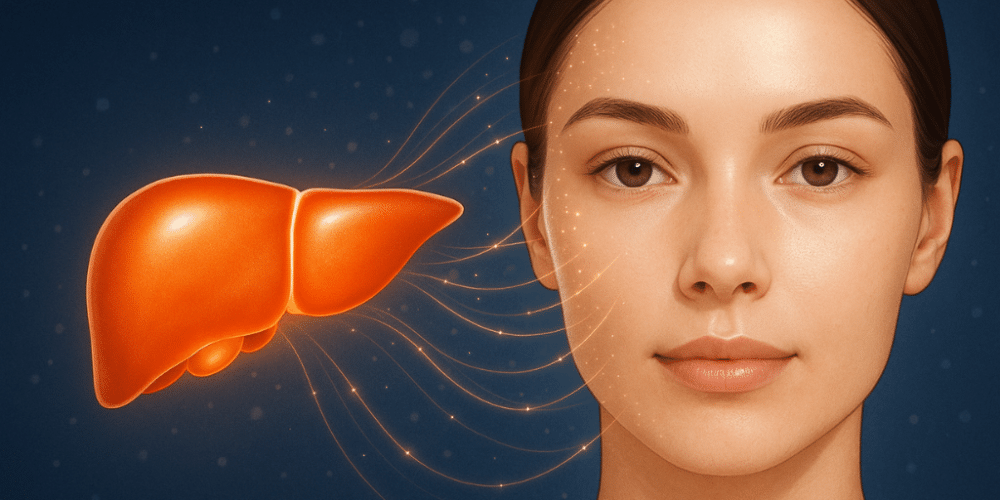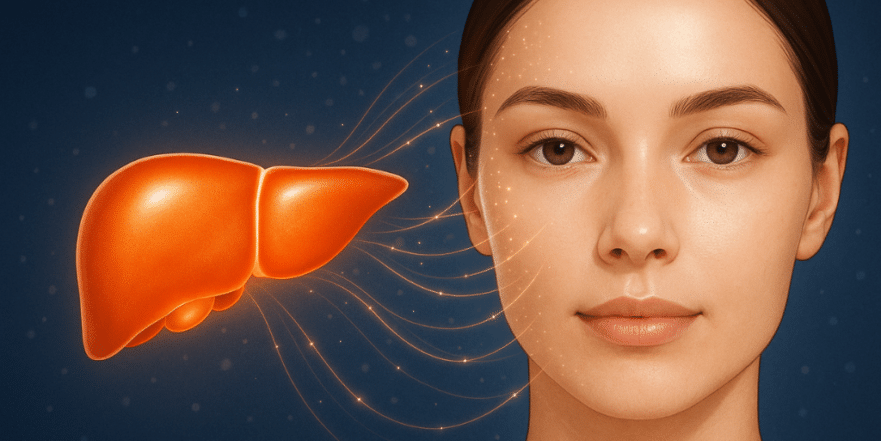
Have you ever looked in the mirror and wondered where those new dark spots, age spots, or patches of melasma came from? You might hear a dozen different theories. Some will tell you it’s a sign of an unhealthy liver. Others will insist you’re low on vitamin C. A third group might blame a mineral deficiency, while a fourth points to a lack of antioxidants on the skin. So, what’s the real truth? The fascinating answer is that they are all correct, because all of these factors are deeply interconnected.
When you start to connect the dots between your internal health and what you see on your skin, a clear picture emerges. The health of your liver, your intake of essential vitamins, and your body’s antioxidant levels all work together in a delicate dance. In this article, we’re going to unravel this complex relationship. We’ll explore why simply treating the surface of your skin often isn’t enough and reveal the single most important mineral you need to address hyperpigmentation from the inside out. Get ready to understand your skin in a whole new way. (Based on the insights of Dr. Vivek Joshi.)
Key Takeaways
- It’s All Connected: Hyperpigmentation, age spots, and melasma are often external signs of deeper internal imbalances involving your liver, vitamin levels, and antioxidant status.
- The Power of Vitamin C: Vitamin C is a potent antioxidant. Consuming foods rich in it not only helps your skin but also directly supports the health and function of your liver.
- Zinc is the Master Mineral: Zinc plays a crucial role in regulating the production of melanin (your skin’s pigment), helping to prevent the overproduction that leads to dark spots.
- Your Liver is Your Mineral Bank: A healthy liver is essential for properly storing and utilizing zinc. Without a well-functioning liver, even zinc supplements may not be effective.
- A Holistic Strategy is Best: The most effective approach to clearing your skin involves a combination of a nutrient-dense diet, targeted supplementation with the right form of zinc, and a healthy lifestyle.
1. It’s All Connected: Why Your Liver, Vitamin C, and Antioxidants Are a Team
When you’re trying to solve the puzzle of hyperpigmentation, it’s easy to get lost in conflicting advice. Is it your liver? Is it a vitamin C deficiency? The truth is, you’re looking at different parts of the same system. Let’s start with vitamin C and antioxidants. These two are often mentioned separately, but vitamin C is, in fact, one of the most powerful antioxidants available to us. When you consume it, you are flooding your body with the free-radical-fighting compounds it needs to protect your cells—including your skin cells—from damage.
Now, how does the liver fit in? To get enough vitamin C and other antioxidants, you need to eat a diet rich in fruits and vegetables—think guavas, bell peppers, oranges, and leafy greens. This is the exact same diet that your liver needs to thrive. When you nourish your body with these whole foods, you are supporting your liver’s detoxification pathways and overall function. A healthy liver is better at processing toxins and managing nutrients, which directly impacts your skin’s health and appearance. So, you see, the path to getting more antioxidants for your skin is the same path to supporting your liver. It all comes back to eating real, nutrient-dense food.
2. Introducing the Master Mineral for Your Skin: Zinc
While a healthy diet is the foundation, there is one specific mineral that stands out as a true game-changer for hyperpigmentation, melasma, and age spots: zinc. Your body cannot produce zinc on its own, which means you must obtain it entirely from your diet or through supplementation. Its importance for skin health is not a new discovery. In Ayurveda, the ancient Indian system of medicine, a special form of zinc powder known as Yashad Bhasma has been used for thousands of years to treat various skin conditions. Modern medical science has since confirmed what ancient practitioners knew all along: zinc is absolutely essential for healthy skin.
When it comes to supplementing, not all forms of zinc are created equal. The best form to look for is zinc glycinate. This type is chelated, meaning the zinc is bound to the amino acid glycine. This makes it incredibly easy for your body to absorb and utilize, and it’s very gentle on your digestive system, so it won’t cause the stomach upset that other forms of zinc sometimes can. This high bioavailability ensures that your body is actually getting and using the zinc you’re taking.
3. The Liver-Zinc Connection: Your Body’s Mineral Bank

Here is where everything truly clicks into place. You can eat all the zinc-rich foods or take the best zinc supplement in the world, but if your body can’t use it properly, you won’t see the benefits. And where does your body store and manage its supply of zinc? You guessed it: the liver. Your liver acts as the primary storage depot for zinc, along with other key areas like the prostate, muscles, bones, and kidneys.
If your liver is sluggish, overburdened, or unhealthy, its ability to store and deploy zinc is compromised. This means you could be in a state of functional zinc deficiency even if your intake is technically high enough. This creates a powerful feedback loop. To effectively use zinc to clear your skin, you need a healthy liver. To get a healthy liver, you need to eat a diet full of fruits and vegetables. And that same diet provides you with the vitamin C and antioxidants that further protect your skin. It all works together. You cannot fix one part of the system without supporting the whole.
4. How Zinc Directly Fights Uneven Skin Tone
So, how does zinc perform its magic on your skin? Its primary role is in the regulation of melanin. Melanin is the pigment that gives your skin, hair, and eyes their color. It’s incredibly important, as it helps protect your skin from the sun’s harmful UV rays. This is why darker skin tones are less prone to sunburn and skin cancer than lighter skin tones. The problem isn’t melanin itself; the problem is the overproduction and uneven distribution of melanin, which results in concentrated patches of pigment that we call age spots, dark spots, or melasma.
Zinc acts as a key regulator in the production of melanin. When your body has sufficient zinc levels, it helps keep melanin synthesis in check, ensuring it’s produced in a balanced, even way. However, as we age, two things happen. First, our body’s ability to absorb zinc from food naturally declines. Second, the process of melanin production can become dysregulated. This combination of lower zinc absorption and faulty melanin signaling is a major driver behind the appearance of age spots. By ensuring your zinc levels are optimal, you provide your body with the tools it needs to manage pigment production correctly.
5. Beyond Melanin: Zinc’s Other Superpowers for Your Skin and Body
Zinc’s benefits for your skin don’t stop at melanin regulation. It’s a powerhouse nutrient that contributes to your skin’s overall health, structure, and resilience in several other ways. For one, zinc is absolutely critical for the production of collagen. Collagen is the protein that forms the structural framework of your skin, giving it firmness, plumpness, and elasticity. If you’re low on zinc, your collagen production will suffer, which can contribute to sagging skin and the formation of fine lines and wrinkles.
Furthermore, zinc is a powerful antioxidant in its own right. It helps protect skin cells from oxidative stress caused by UV radiation and environmental pollutants, which is a primary cause of premature aging. Beyond the skin, zinc is famous for its role in supporting a robust immune system. If you find yourself getting sick frequently, it could be a sign that your zinc levels are too low. A strong immune system is fundamental to your body’s ability to repair and maintain healthy tissue, including your skin.
6. Your Action Plan: How to Get the Right Amount of Zinc
Now that you understand why zinc is so important, let’s talk about a practical action plan. The best approach is always to start with your diet.
- Focus on Food First: Incorporate zinc-rich foods into your daily meals. Some of the best sources include pumpkin seeds, oysters, beef, lentils, chickpeas, cashews, and hemp seeds. Just one to two tablespoons of pumpkin seeds a day can give you a significant boost. However, remember that your ability to absorb these nutrients depends on good digestion. A healthy gut is paramount.
- Supplementing Smartly: For those dealing with stubborn hyperpigmentation, supplementing can be highly effective. As mentioned, choose zinc glycinate for its superior absorption. For general support or mild issues, a dose of 17 mg per day is often sufficient. If you have more significant melasma or dark spots, you might consider 34 mg per day. Always take zinc with a meal, preferably in the first half of the day, to prevent any stomach discomfort.
- Cycle Your Supplementation: It’s wise to cycle your zinc intake. A good protocol is to take the supplement daily for two to three months, and then take a one-month break. This prevents your body from becoming too accustomed to it and helps maintain balance.
- A Crucial Warning: Do not overdo it with zinc. Taking excessively high doses for long periods can interfere with your body’s absorption of other essential minerals, particularly copper, leading to an imbalance. Stick to the recommended dosages.
Conclusion
Ultimately, achieving clear, radiant, and evenly toned skin is an inside job. It’s not about a single magic cream or a quick fix. It’s about understanding and honoring the deep connection between what you eat, how your internal organs are functioning, and what you see in the mirror. By focusing on a nutrient-rich diet to support your liver, you create the perfect environment for your body to use the master mineral, zinc, effectively. When you combine a healthy lifestyle with a targeted approach to nutrition and supplementation, you empower your body to heal and balance itself from within. Here’s to your health and your beautiful, glowing skin.
Source: Dr. Vivek Joshi

